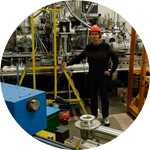About This Project
Wormholes, often depicted as tunnels connecting distant points in space and time, are theoretical structures predicted by General Theory of Relativity.
However, these wormholes require very specific conditions to remain open. Without these conditions, they could become unstable and collapse, essentially pinching off the connection they provide.
We hypothesize that a collapsing wormhole would emit a distinctive gravitational wave signal, potentially detectable by the LIGO observatory.
Ask the Scientists
Join The DiscussionWhat is the context of this research?
The universe, described by Einstein's general relativity, may harbor exotic objects like wormholes—theoretical tunnels connecting distant regions of spacetime. Unlike confirmed gravitational wave (GW) sources like merging neutron stars or black holes, the observational fingerprints of wormholes are speculative. However, a major hurdle for wormholes to exist and remain stable in the universe is the requirement for hypothetical "exotic" matter – a material with negative pressure and density. Without this wormholes would be unstable and collapse. The key question is: what gravitational radiation would they emit, and could we ever hope to detect it? This project focuses on calculating the characteristic GW spectrum produced by the collapse of wormholes. By performing detailed computations, we will generate theoretical templates of this radiation, allowing us to assess its potential detectability by instruments like Laser Interferometer Gravitational-Wave Observatory (LIGO).
What is the significance of this project?
Gravitational waves (GW) —ripples in the fabric of spacetime—are our unique probe for the universe's most violent events. While gravitational waves from neutron stars and black hole mergers are now observed, the gravitational radiation signature from other predicted cosmic cataclysms, like theoretical wormhole collapse, remains unknown but crucial for testing General Relativity. Our project aims to fill this gap: we will compute the precise GW spectrum expected from the collapse of wormholes, particularly those not supported by exotic matter. We hypothesize that this collapse generates a unique, potentially detectable GW signal. By providing these essential theoretical gravitational wave templates, our work will determine if this signal is within the sensitivity range of current (LIGO) or future (LISA) GW observatories. This research is vital as it provides GW astronomy with the specific 'fingerprint' needed to guide observational searches.
What are the goals of the project?
A central and crucial task of this project is the precise calculation of the gravitational wave spectrum and waveform emitted during the collapse of theoretical wormholes. This is achieved through complex numerical simulations run on high-performance computing resources. These simulations model the highly dynamic spacetime evolution as a wormhole collapses, including the influence of any associated matter dynamics, which together determine the characteristics of the outgoing gravitational radiation. By accurately extracting and analyzing the gravitational waves produced in these simulations, we generate the predicted spectrum and waveform templates. This calculation is vital because these theoretical templates are the essential 'fingerprint' needed to assess if the signal is strong enough to be detected by current or future gravitational wave observatories and to guide experimentalists on what specific patterns to search for in the data.
Budget
High-Performance Computing (GPUs) Allocation: Provides the critical computational power essential for gravitational wave emission calculations.
PI Salary Support: Enables dedicated time for Principal Investigators to provide scientific leadership, design simulations, analyze data, and interpret results, ensuring successful project execution.
Endorsed by
 Project Timeline
Project Timeline
The core computational phase will focus on calculating the gravitational wave spectrum and waveform produced during wormhole collapse. This requires developing or adapting a high-performance numerical relativity code, utilizing established frameworks like Einstein Toolkit, GRChombo, or WarpFactory. This adapted code will execute a suite of high-resolution, parallel simulations on high-performance computing resources.
Jun 15, 2025
Framework Selection & Initial Setup
Jun 22, 2025
Project Launched
Jul 15, 2025
Core Code Implementation & Testing
Aug 15, 2025
Execution of Primary Simulation Suite
Sep 15, 2025
Data Analysis and Key Result Extraction
Meet the Team
Team Bio
Shirokov Ilya is a PhD mathematician from Steklov Mathematical Institute. His primary research focuses on differential geometry and topology.
Abner Hernandez Rodrigues is a mathematician from Mexico who earned a Master's degree in Mathematics from Moscow State University (MSU).
Their combined skills in fundamental mathematical theory and advanced computational techniques make this team exceptionally well-equipped to achieve the project's defined goals.
Nikita Shirokov
I hold a Bachelor's degree in Aerospace Engineering and a Master's degree in Physics. My Master's studies were completed at the Moscow Institute of Physics and Technology (MIPT), within the Department of Theoretical Physics at the Joint Institute for Nuclear Research (JINR). There, I conducted theoretical research across various fields including cosmology, gravitational wave physics, neutrino physics, and condensed matter physics. While my academic path has been diverse, my persistent underlying focus and deep passion have always been directed towards interstellar travel and finding viable pathways to make human exploration beyond our solar system a reality. This project on wormhole dynamics represents a highly promising avenue aligned with this long-term goal. I have the following youtube channel related to the topic of wormholes and warpdrive First Interstellar Institute.
Lab Notes
Nothing posted yet.
Project Backers
- 0Backers
- 0%Funded
- $0Total Donations
- $0Average Donation

